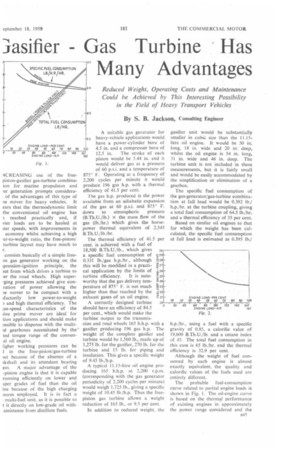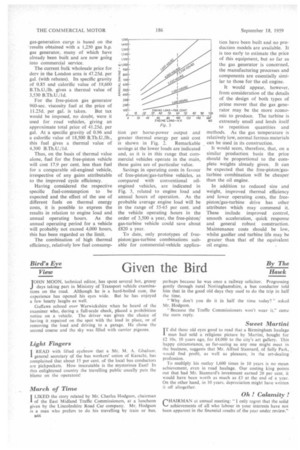iasifier Gas Turbine Has Many Advantages
Page 79

Page 80

If you've noticed an error in this article please click here to report it so we can fix it.
Reduced Weight, Operating Costs and Maintenance Could be Achieved by This Interesting Possibility in the Field of Heavy Transport Vehicles
By S. B. Jackson, Consulting Engineer sICREASING use of the freepiston-gasifier gas-turbine combinaion for marine propulsion and ■ er generation prompts consideraof the advantages of this type of [le mOver for heavy vehicles. It ears that the thermodynamic limit the conventional oil engine has reached practically and, if vier loads are to be hauled at tter speeds, with improvements in economy whilst achieving a high ,er-to-weight ratio, the free-piston/ turbine layout may have much to r. consists basically of a simple freeon gas generator working on the ipression-ignition principle, the nit from which drives a turbine to ,er the road wheels. High super-ging pressures achieved give con„ration of power allowing the le mover to be compact with a ifactorily low power-to-weight 3 and high thermal efficiency. The [ue-speed characteristics of the iine prime mover are ideal for non applications and should make ossible to dispense with the multi;4:1 gearboxes necessitated by the ted torque range of the convenal oil engine. figher working pressures can be 1 in the free-piston/gas-turbine iut because of the absence of a ikshaft and its attendant bearing em. A major advantage of the -piston engine is that it is capable running efficiently on lower and 3.per grades of fuel than the oil inc because of the high charging ;sures employed. It is in fact a m uiti-fuel unit, as it is possible to t it directly on low-grade oil withassistance from distillate fuels. A suitable gas generator for 1).2. heavy-vehicle applications would have a power-cylinder bore of
E NEOAD -PERC NGI LENT.
.3,0 40 so qo 70 so 99 co 4.5 in. and a compressor bore of 41) 611' so ' 40'l0 140' 16.0 12.5 in. The stroke of each piston would be 5.44 in. and it would deliver gas at a pressure of 60 psi. and a temperature of 875° F. Operating at a frequency of 2,200 cycles per minute it would produce 196 gas h.p. with a thermal efficiency of 41.5 per cent. The gas h.p. produced is the power available from an adiabatic expansion of the gas at 60 p.s.i. and 875° F. down to atmospheric pressure (B.Th.U./lb.) X the mass flow of the gas (lb.! hr.) which gives the horsepower thermal equivalent of 2,545 B.Th.U./lb./hr. The thermal efficiency of 41.5 per cent. is achieved with a fuel of 18,500 B.Th.U./lb., which gives 30 a specific fuel consumption of t29 0.331 lb./gas h.p./hr., although d2s this will be modified in a practical application by the limits of turbine efficiency. It is note-5z 29 worthy that the gas delivery tem12+ perature of 8750 F. is not much g23 higher than that reached by the n exhaust gases of an oil engine.
A correctly designed turbine 20 should have an efficiency of 84.5 per cent., which would make the turbine output to the transmis sion and road wheels 165 b.h.p. with a gasifier producing 196 gas h.p. The weight of the complete gasifier and turbine would be 1,560 lb., made up of 1,275 lb. for the gasifier, 270 lb. for the turbine and 15 lb. for piping and insulation. This gives a specific weight of 9.45 Ib./h.p. A typical 11.15-litre oil engine producing 165 b.h.p. at 2,200 r.p.m. (corresponding with the gas generator periodicity of 2,200 cycles per minute) would weigh 1,725 lb., giving a specific weight of 10.45 lb./h.p. Thus the freepiston gas turbine allows a weight reduction of 165 lb., or 9.5 per cent. In addition to reduced weight. the gasifier unit would be substantially smaller in cubic size than the 11.15litre oil engine, It would be 50 in. long, 18 in. wide and 20 in: deep, whilst the oil engine is 54 in. long, 31 in. wide and 46 in. deep. The turbine unit is not included in these measurements, but it is fairly small and would be easily accommodated by the simplification or elimination of a gearbox. The specific fuel consumption of the gas-generator/gas-turbine combination at full load would be 0.392 lb./ h.p./hr. at the turbine coupling, giving a total fuel consumption of 645 lb./hr. and a thermal efficiency of 35 per cent. Based on similar oil engines to that for which the weight has been calculated, the specific fuel consumption at full load is estimated as 0.395 lb./ h.p./hr., using a fuel with a specific gravity of 0.85, a calorific value of 19,600 B.Th.U./lb. and a cetane index of 45. The total fuel consumption in this case is 65 lb./hr. and the thermal efficiency is 32.9 per cent. Although the weight of fuel consumed by each engine is almost exactly equivalent, the quality and calorific values of the fuels used are entirely different. The probable fuel-consumption curve related to partial engine loads is shown in Fig. 1. The oil-engine curve is based on the thermal performance of existing engines in approximately the power range considered and the
gas-generation curye is based on the results obtained with a 1,250 gas h.p. gas generator, many of which have already been built and are now going into commercial service.
The current bulk wholesale price for dery in the London area is 47.25d. per gal. (with rebates). Its specific gravity of 0.85 and calorific value of 19,600 B.Th.U./lb. gives a thermal value of 3,530 B.Th.U./1d.
For the free-piston gas generator 960-sec. viscosity fuel at the price of 11.25d. per gal. is taken. But tax would be imposed, no doubt, were it used for road vehicles,. giving an approximate total price of 41.25d. per gal. At a specific gravity of 0.96 and a calorific value of 18,500 B.Th.U./lb., this fuel gives a thermal value of 4,300 B.Th.U./1d.
Thus, on the basis of thermal value alone, fuel for the free-piston vehicle will cost 17.9 per cent, less than fuel for a comparable off-engined vehicle, irrespective of any gains attributable to the improved cycle efficiency.
Having considered the respective specific fuel-consumption to be expected and the effect of the use of different fuels on thermal energy costs, it is possible to express the results in relation to engine load and annual operating hours. As the annual operating period for a vehicle will probably not exceed 4,000 hours, this has been regarded as the limit.
The combination of high thermal efficiency, relatively low fuel consump tion per horse-power output and greater thermal energy per unit cost is shown in Fig. 2. Remarkable savings at the lower loads are indicated and, as it is in this range that commercial vehicles operate in the main, these gains are of particular value.
Savings in operating costs in favour of free-piston/gas-turbine vehicles, as compared with conventional oilengined vehicles, are indicated in Fig. 3, related to engine load and annual hours of operation. As the probable average engine load will be in the range of 55-65 per cent, and the vehicle operating hours in the order of 3,500 a year, the free-piston/ gas-turbine vehicle could save about £820 a year.
To date, only prototypes of freepiston/gas-turbine combinations suitable for commercial-vehicle applica
lion have been built and no production models are available. It is too early to estimate the price of this equipment, but so far as the gas generator is concerned, the manufacturing processes and components are essentially similar to those for the oil engine.
It would appear, however, from consideration of the details of the design of both types of prime mover that the gas generator may be the more economic to produce. The turbine is 165 extremely small and lends itself to repetition quantities and methods. As the gas temperature is relatively low, normal ferrous materials can be used in its construction.
It would seem, therefore, that, on a similar production basis the price should be proportional to the complete weights already given. It can be expected that the free-piston/gasturbine combination will be cheaper than the oil engine.
In addition to reduced size and weight, improved thermal efficiency and lower operating costs, the freepiston/gas-turbine drive has other attributes which may commend it. These include improved control, smooth acceleration, quick response and general robust construction. Maintenance costs should be low, whilst gasifier and turbine life may be greater than that of the equivalent oil engine.




































































































































